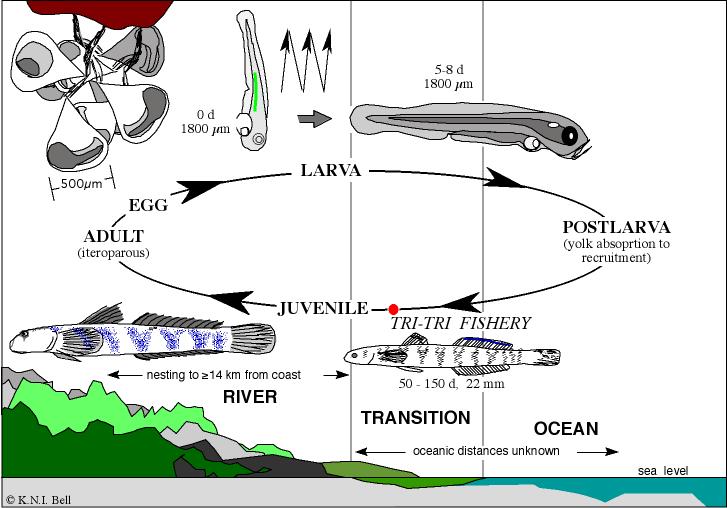Diadromous fishes are any fish species that migrate between fresh and salt waters during the course of their life span. Often they migrate to find food and/or to breed.
However, scientists often use the words anadromous, catadromous, and amphidromous because these terms are applied to specific types of migratory patterns.
Anadromous species (of which the sea lamprey is one) lay eggs in freshwater, grow as larvae and juveniles there for some time, before returning to the ocean where the majority of their growth occurs. Note that ocean in this case can include any salt waters, from estuaries to open ocean. After growing in the oceans the adults return to spawn in freshwater. Some species are semelparous (meaning they only spawn once and then will die, as is the case with Pacific salmon), but iteroparous (species that spawn more than once) species are also common. Numerous species have individuals that maybe semelparous while others are iteroparous within the same population. In the Northeast we have many anadromous species including: American shad (Alosa sapidissima), alewife (Alosa pseudoharengus), blueback herring (Alosa aestivalis), striped bass (Morone saxatilis), Atlantic sturgeon (Acipenser oxyrinchus), sea lamprey (Petromyzon marinus), and Atlantic salmon (Salmo salar) amongst others (see http://www.umaine.edu/searunfish/fish/diadromous.htm for more information and excellent sources).
 |
| Figure 1. Anadromous life cycle of a Pacific salmon (Oncorhynchus spp.), a group of species native to the West Coast, but which demonstrates an identical life strategy to anadromous species on the East Coast. Image taken from http://www.marinwatersheds.org/salmonids.html. |
 |
| Figure 2. Catadromous life cycle of the American eel (Anguilla rostrata). Eels around the world are under serious threat and American eel is no different, you can read more about it at http://www.chesapeakebay.net/fieldguide/critter/american_eel. Image from http://bioweb.uwlax.edu/bio203/s2009/peaslee_alex/Anguilla_Japonica/Life_Cycle.html. |
Amphidromous species have eggs laid in freshwater, migrate downstream to the ocean to grow, but then return to freshwater to continue growth. Once they are fully mature they will spawn (likely numerous times) in the rivers in which they reside. Note here the real difference between this and the other two prior strategies is that growth occurs both in the ocean and in freshwater. In the Northeast we have no amphidromous species, as this life history strategy is primarily limited to tropical and semitropical gobies.
 |
| Figure 3. Amphidromous life cycle, showing the days and approximate size for Sicydium punctatum, a Dominicana goby. Image take from Dr. Bell, http://www.ucs.mun.ca/~kbell/goby/Intro.html,see his webpage for further details. |




